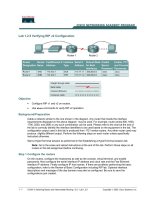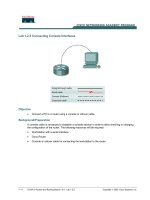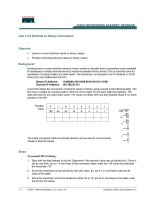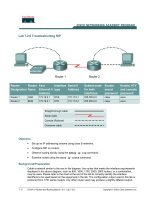Tài liệu Lab 1.2.5 Verifying RIP v2 Configuration pdf
Bạn đang xem bản rút gọn của tài liệu. Xem và tải ngay bản đầy đủ của tài liệu tại đây (137.83 KB, 7 trang )
1 - 7 CCNA 3: Switching Basics and Intermediate Routing v 3.0 - Lab 1.2.5 Copyright 2003, Cisco Systems, Inc.
Lab 1.2.5 Verifying RIP v2 Configuration
Objective
• Configure RIP v1 and v2 on routers.
• Use show commands to verify RIP v2 operation.
Background/Preparation
Cable a network similar to the one shown in the diagram. Any router that meets the interface
requirements displayed on the above diagram may be used. For example, router series 800, 1600,
1700, 2500, and 2600 or any such combination can be used. Please refer to the chart at the end of
the lab to correctly identify the interface identifiers to be used based on the equipment in the lab. The
configuration output used in this lab is produced from 1721 series routers. Any other router used may
produce slightly different output. Perform the following steps on each router unless specifically
instructed otherwise.
Start a HyperTerminal session as performed in the Establishing a HyperTerminal session lab.
Note: Go to the erase and reload instructions at the end of this lab. Perform those steps on all
routers in this lab assignment before continuing.
Step 1 Configure the routers
On the routers, configure the hostnames as well as the console, virtual terminal, and enable
passwords. Next configure the serial interface IP address and clock rate and the Fast Ethernet
interface IP address. Finally configure IP host names. If there are problems performing the basic
configuration, refer to the Review of Basic Configuration including RIP lab. Optional interface
descriptions and message of the day banners may also be configured. Be sure to save the
configurations just created.
2 - 7 CCNA 3: Switching Basics and Intermediate Routing v 3.0 - Lab 1.2.5 Copyright 2003, Cisco Systems, Inc.
Step 2 Configure the routing protocol on the Gadsden router
Go to the correct command mode and configure RIP routing on the Gadsden router according to the
chart.
Step 3 Save the Gadsden router configuration
Any time that changes are correctly made to the running configuration, they should be saved to the
startup configuration. Otherwise, if the router is reloaded or power cycled, the changes that are not
saved in the startup configuration will be lost.
Step 4 Configure the routing protocol on the Birmingham router
Go to the correct command mode and configure RIP routing on the Birmingham router according to
the chart.
Step 5 Save the Birmingham router configuration
Step 6 Configure the hosts with the proper IP address, subnet mask, and default gateway
Step 7 Verify that the internetwork is functioning by pinging the FastEthernet interface of
the other router
a. From the host attached to the GAD, ping the other host attached to the BHM router. Was the
ping successful?
________
b. From the host attached to the BHM, ping the other host attached to the GAD router. Was the
ping successful?
________
c. If the answer is no for either question, troubleshoot the router configurations to find the error.
Then do the pings again until the answer to both questions is yes.
Step 8 Show the routing tables for each router
a. From the enable privileged EXEC mode, examine the routing table entries using command show
ip route command on each router.
b. What are the entries in the GAD routing table?
__________________________________________________________________________
__________________________________________________________________________
__________________________________________________________________________
c. What are the entries in the BHM routing table?
__________________________________________________________________________
__________________________________________________________________________
__________________________________________________________________________
Step 9 Enable RIP v2 routing
Enable version 2 of the RIP routing protocol on both of the routers, Gadsden and Birmingham.
GAD(config)#router rip
GAD(config-router)#version 2
GAD(config-router)#exit
GAD(config)#exit
3 - 7 CCNA 3: Switching Basics and Intermediate Routing v 3.0 - Lab 1.2.5 Copyright 2003, Cisco Systems, Inc.
BHM(config)#router rip
BHM(config-router)#version 2
BHM(config-router)#exit
BHM(config)#exit
Step 10 Show the routing tables
a. Show the routing tables on both routers again.
b. Have they changed now that RIP v2 is now being used instead of RIP v1?
________________
c. What is the difference between RIP v2 and RIP v1?
________________________________
d. What must be done in order to see a difference between RIP v2 and RIP v1?
__________________________________________________________________________
Step 11 Change the Fast Ethernet IP subnet mask on the Gadsden router
a. Change the subnet mask on router GAD from a class B (255.255.0.0) to a Class C
(255.255.255.0). Use the same IP address.
GAD(config)#interface fastethernet 0
GAD(config-if)#ip address 172.16.0.1 255.255.255.0
GAD(config-if)#exit
b. How does this change affect the address for the FastEthernet interface?
__________________________________________________________________________
Step 12 Show the GAD routing table
a. Show the GAD routing table.
b. Has the output changed with the addition of a subnetted IP address?
________________
c. How has it changed?
_______________________________________________________
Step 13 Show the BHM routing table
a. Show the BHM routing table.
b. Has the output changed with the addition of a subnetted IP address?
_____________
Step 14 Change the network addressing scheme
Change the addressing scheme of the network to a single class B network with a class C subnet (8-
bits of subnetting).
a. On the BHM router:
BHM(config)#interface serial 0
BHM(config-if)#ip address 172.16.1.2 255.255.255.0
BHM(config-if)#exit
BHM(config)#interface fastethernet 0
BHM(config-if)#ip address 172.16.3.1 255.255.255.0
BHM(config-if)#exit
BHM(config)#exit
4 - 7 CCNA 3: Switching Basics and Intermediate Routing v 3.0 - Lab 1.2.5 Copyright 2003, Cisco Systems, Inc.
b. On the GAD router:
GAD(config)#interface serial 0
GAD(config-if)#ip address 172.16.1.1 255.255.255.0
GAD(config-if)#exit
Step 15 Show the routing table
a. Show the GAD routing table.
b. Has the output changed with the addition of subnetted IP addresses?
________________
c. How has it changed?
_______________________________________________________
Step 16 Show the routing table
a. Show the BHM routing table.
b. Has the output changed with the addition of a subnetted IP address?
________________
Step 17 Change the host configurations
Change the host configuration to reflect the new IP addressing scheme of the network
Step 18 Ping all of the interfaces on the network from each host
a. Were all of the interfaces still able to be pinged?
__________________________________
b. If not, troubleshoot the network and ping again.
Step 19 Use show ip route to see different routes by type
a. Enter show ip route connected on the GAD router.
b. What networks are displayed?
________________________________________________
c. What interface is directly connected?
___________________________________________
d. Enter show ip route rip
e. List the routes listed in the routing table?
_________________________________________
f. What is the administrative distance?
____________________________________________
g. Enter show ip route connected on the BHM router.
h. What networks are displayed?
________________________________________________
i. What interface is directly connected?
___________________________________________
j. Enter show ip route rip
k. List the routes listed in the routing table?
_________________________________________
Step 20 Use the show IP protocol command
a. Enter show ip protocol on the GAD router.
b. When will the routes be flushed?
______________________________________________
c. What is the default distance listed for RIP?
_______________________________________
5 - 7 CCNA 3: Switching Basics and Intermediate Routing v 3.0 - Lab 1.2.5 Copyright 2003, Cisco Systems, Inc.
Step 21 Remove the version 2 option
Remove the version 2 option on the RIP configuration for both routers.
Step 22 Show the routing table
a. Show the GAD routing table.
b. Has the output changed now that version 2 of RIP was removed?
______________________
Step 23 Show the routing table
a. Show the BHM routing table.
b. Has the output changed now that version 2 of RIP was removed?
______________________
Once the previous steps are completed, log off by typing exit, and turn the router off. Then remove
and store the cables and adapter.









